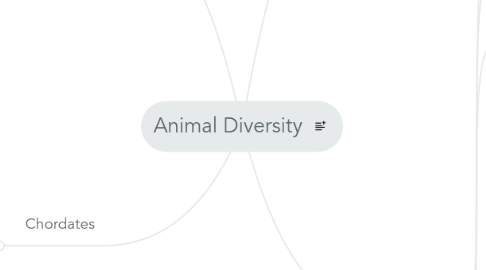
1. 4 branch point
1.1. 1. ancestral protist
1.1.1. porifera
1.1.2. 2. eumetazoa
1.1.2.1. cnidaria
1.1.2.2. 3. bilateral
1.1.2.2.1. 4
1.1.2.2.2. Deuterostomia
2. Chordates
2.1. Not many species
2.1.1. great body features diverse
2.2. Characteristics
2.2.1. Notochord
2.2.1.1. flexible rod
2.2.1.1.1. between digestive system & nerve chord
2.2.1.2. provides firm but flexible structures
2.2.1.3. reduced to part of gelatinous disk
2.2.1.3.1. between vertebrae
2.2.2. dorsal, hollow nerve chord
2.2.2.1. developed from ectoderm tube
2.2.2.1.1. dorsal to notochord
2.2.2.2. developed into central nervous system
2.2.2.2.1. brain
2.2.2.2.2. spinal chord
2.2.3. muscular, post-anal tail
2.2.3.1. helps propel aquatic chordates
2.2.3.2. significantly reduced in some adult
2.2.4. pharyngeal gill slits or clefts
2.2.4.1. allow water pass through
2.2.4.1.1. passing digestive system
2.2.4.2. may be used in
2.2.4.2.1. suspension feeding
2.2.4.2.2. gill slits
2.2.4.2.3. part of head / neck / inner ear
2.3. Example
2.3.1. lancelets
2.3.1.1. most basal living
2.3.1.2. cephalochordate
2.3.2. tunicates
2.3.2.1. undergo metamorphosis
2.3.3. craniates
2.3.3.1. exhibit cephalization
2.3.3.2. hagfish
2.3.3.2.1. most basal craniates
2.3.3.3. vertebrates
2.3.3.3.1. Hox genes duplication
2.3.3.3.2. lampreys
3. Characteristis
3.1. multicellular eukaryotes
3.1.1. no cell calls
3.1.2. cells organized into tissues
3.1.2.1. nerve & muscle tissue
3.1.2.1.1. move body
3.1.2.1.2. conduct nerve impulses
3.1.2.2. Differentiate animals from fungi & plants
3.2. heterotrophic by ingestion
3.2.1. Task
3.2.2. Prerequisites
3.3. store carbohydrates as glycogen
3.4. exception: Elysia chlorotica
3.4.1. autotrophic animal
3.4.2. kleptoplast
3.4.3. sap sucking sea slug
4. animals:
4.1. 1.3 extant species
4.1.1. 99% species extinct
4.2. monophyletic
4.2.1. common ancestor: choanoflagellate (protist)
4.3. 1st macroscopic animal fossils
4.3.1. Ediacaran biota
4.3.2. 565-550 MYA
4.3.3. soft-bodied
4.3.3.1. sponges
4.3.3.2. relatives of cnidarian (jellyfish)
4.4. Cambrian explosion
4.4.1. rapid diversification
4.4.2. 530 MYA
4.4.3. 1st complex
4.4.3.1. hard, mineralized skeleton
4.4.4. most major phyla present
4.4.5. factors
4.4.5.1. extrinsic
4.4.5.1.1. atmospheric O2 level
4.4.5.1.2. calcium in Cambria sea
4.4.5.1.3. mass extinction of Ediacaran fauna
4.4.5.1.4. evolutionary arms race
4.4.5.2. intrinsic
4.4.5.2.1. origin of Hox genes
4.5. diversify
4.5.1. fish: top predators in the ocean
4.5.2. arthropods to land 460 MYA
4.5.2.1. centipedes & millipedes
4.5.2.2. fossilized fern galls 300 MYA
4.5.3. vertebrates to land 365 MYA
4.6. K/T mass extinction
4.6.1. dinosaur extinct
4.6.2. mammals diverse
